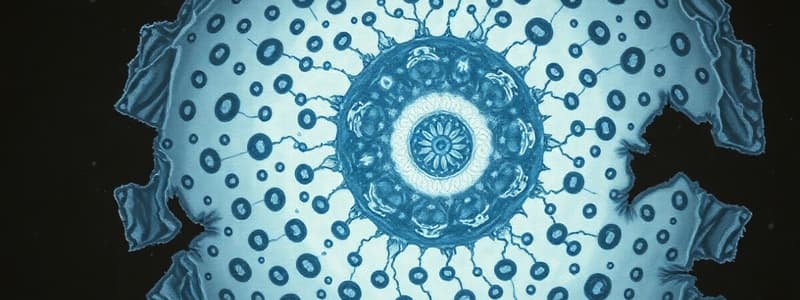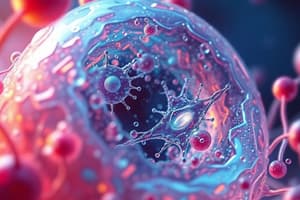Podcast
Questions and Answers
What is considered the basic unit of life?
What is considered the basic unit of life?
- Organ
- Molecule
- Tissue
- Cell (correct)
Which microscope can magnify up to 1000 times using oil immersion?
Which microscope can magnify up to 1000 times using oil immersion?
- Light Microscope (correct)
- Transmission Electron Microscope
- Fluorescent Microscope
- Scanning Electron Microscope
Who was the first to observe cells and name them 'Cellula'?
Who was the first to observe cells and name them 'Cellula'?
- Anton Van Leeuwenhoek
- Robert Hooke (correct)
- Stanley Miller
- Harold Urey
Which type of electron microscope uses electrons to produce a three-dimensional image?
Which type of electron microscope uses electrons to produce a three-dimensional image?
What significant experiment demonstrated the synthesis of amino acids in early Earth conditions?
What significant experiment demonstrated the synthesis of amino acids in early Earth conditions?
Which of the following cells is regarded as the largest?
Which of the following cells is regarded as the largest?
What is the primary purpose of a Confocal Microscope?
What is the primary purpose of a Confocal Microscope?
Which type of cell is characterized as being simpler and lacking a nucleus?
Which type of cell is characterized as being simpler and lacking a nucleus?
What is the resolution limit of a light microscope?
What is the resolution limit of a light microscope?
Which part of a microscope is primarily responsible for magnification?
Which part of a microscope is primarily responsible for magnification?
In what year did Stanley Miller conduct his famous experiment on the origin of life?
In what year did Stanley Miller conduct his famous experiment on the origin of life?
Which component is common to both prokaryotic and eukaryotic cells?
Which component is common to both prokaryotic and eukaryotic cells?
Which characteristic is not typical of living things?
Which characteristic is not typical of living things?
What is the primary function of the cell membrane?
What is the primary function of the cell membrane?
How do passive transport processes primarily function?
How do passive transport processes primarily function?
What are glycolipids mainly used for in the cell membrane?
What are glycolipids mainly used for in the cell membrane?
What type of channel allows the passage of water in cell membranes?
What type of channel allows the passage of water in cell membranes?
Which of the following describes secondary active transport?
Which of the following describes secondary active transport?
Endocytosis is primarily associated with which process?
Endocytosis is primarily associated with which process?
What role do actin filaments play in the cell?
What role do actin filaments play in the cell?
What is the main characteristic of the fluid mosaic model of the cell membrane?
What is the main characteristic of the fluid mosaic model of the cell membrane?
Which of the following processes does NOT require energy?
Which of the following processes does NOT require energy?
Where are ion channels typically found?
Where are ion channels typically found?
What structural feature differentiates phospholipids from triglycerides?
What structural feature differentiates phospholipids from triglycerides?
Which type of transport specifically requires ATP?
Which type of transport specifically requires ATP?
What describes the function of receptors in the membrane?
What describes the function of receptors in the membrane?
What role does cholesterol play in cellular membranes?
What role does cholesterol play in cellular membranes?
Flashcards
Cell
Cell
The basic unit of life, a small, enclosed membrane-bound structure containing protoplasm.
Cell Theory
Cell Theory
All living things are composed of cells, cells come from pre-existing cells, and cells have similar chemical compositions.
Prokaryotic Cell
Prokaryotic Cell
A simple cell structure, lacking a nucleus and other membrane-bound organelles.
Eukaryotic Cell
Eukaryotic Cell
Signup and view all the flashcards
Light Microscope
Light Microscope
Signup and view all the flashcards
Electron Microscope
Electron Microscope
Signup and view all the flashcards
Transmission Electron Microscope (TEM)
Transmission Electron Microscope (TEM)
Signup and view all the flashcards
Scanning Electron Microscope (SEM)
Scanning Electron Microscope (SEM)
Signup and view all the flashcards
Homeostasis
Homeostasis
Signup and view all the flashcards
Magnification
Magnification
Signup and view all the flashcards
Resolution
Resolution
Signup and view all the flashcards
Robert Hooke
Robert Hooke
Signup and view all the flashcards
Anton van Leeuwenhoek
Anton van Leeuwenhoek
Signup and view all the flashcards
Miller-Urey Experiment
Miller-Urey Experiment
Signup and view all the flashcards
Protoplasm
Protoplasm
Signup and view all the flashcards
Cell Membrane
Cell Membrane
Signup and view all the flashcards
Phospholipid Bilayer
Phospholipid Bilayer
Signup and view all the flashcards
Passive Transport
Passive Transport
Signup and view all the flashcards
Active Transport
Active Transport
Signup and view all the flashcards
Endocytosis
Endocytosis
Signup and view all the flashcards
Exocytosis
Exocytosis
Signup and view all the flashcards
Cytoskeleton
Cytoskeleton
Signup and view all the flashcards
Microtubules
Microtubules
Signup and view all the flashcards
Nuclear Lamina
Nuclear Lamina
Signup and view all the flashcards
Lysosomes
Lysosomes
Signup and view all the flashcards
Endoplasmic Reticulum (ER)
Endoplasmic Reticulum (ER)
Signup and view all the flashcards
Golgi Apparatus
Golgi Apparatus
Signup and view all the flashcards
Ribosomes
Ribosomes
Signup and view all the flashcards
Transcription
Transcription
Signup and view all the flashcards
Translation
Translation
Signup and view all the flashcards
Cell Junctions
Cell Junctions
Signup and view all the flashcards
Study Notes
Cell Structure and Function
- Living things are highly organized, reproduce, maintain homeostasis, respond to stimuli, grow and develop, take energy, and adapt to their environment.
- Cells are the fundamental units of life. They are too small to see with the naked eye.
- Microscopes are used to view cells. Light microscopes can magnify up to 1000 times, while electron microscopes have much higher resolution (1-10 Å).
- Cell theory: Cells are the basic unit of life, cells come from preexisting cells, and all living things are composed of cells.
Cell Types
- Prokaryotes are unicellular organisms without a nucleus or membrane-bound organelles. Their DNA is in a nucleoid region. Examples are bacteria.
- Eukaryotes are cells with a nucleus and membrane-bound organelles. Examples are animal and plant cells.
Cell Structure
- Cell membrane (plasma membrane): A thin, flexible barrier around the cell. It's selectively permeable, regulating what enters and leaves the cell. The fluid mosaic model describes the membrane; it's a phospholipid bilayer with embedded proteins.
- Cytoskeleton: A network of protein fibers (microfilaments, microtubules, and intermediate filaments) that gives the cell shape, support, and allows movement.
- Nucleus: The control center of the cell. It contains DNA, which directs cell activities.
Organelles
- Endoplasmic reticulum (ER): A network of membrane-bound sacs and tubules. Rough ER has ribosomes, synthesizing proteins, and smooth ER synthesizes lipids.
- Ribosomes: Build proteins based on instructions from DNA.
- Golgi apparatus: Processes, packages, and distributes proteins.
- Mitochondria: The powerhouses of the cell, where cellular respiration occurs, producing ATP.
- Lysosomes: Contain enzymes to break down cellular waste and debris.
- Vacuoles: Storage sacs for water, nutrients, or waste products.
Transport Across Cell Membranes
- Passive transport: Movement of substances across the membrane without energy. This includes diffusion (high to low concentration), facilitated diffusion (with protein help), and osmosis (water movement).
- Active transport: Movement of substances against their concentration gradient, requiring energy (ATP). This includes pumps (like the sodium-potassium pump), endocytosis (taking in molecules), and exocytosis (releasing molecules).
Cell-Cell Interactions
- Cell junctions: Specialized structures that connect adjacent cells, including tight junctions, adherens junctions, and desmosomes.
- Gap junctions: Communicate between cells by allowing small molecules and ions to pass directly through channels.
Studying That Suits You
Use AI to generate personalized quizzes and flashcards to suit your learning preferences.




